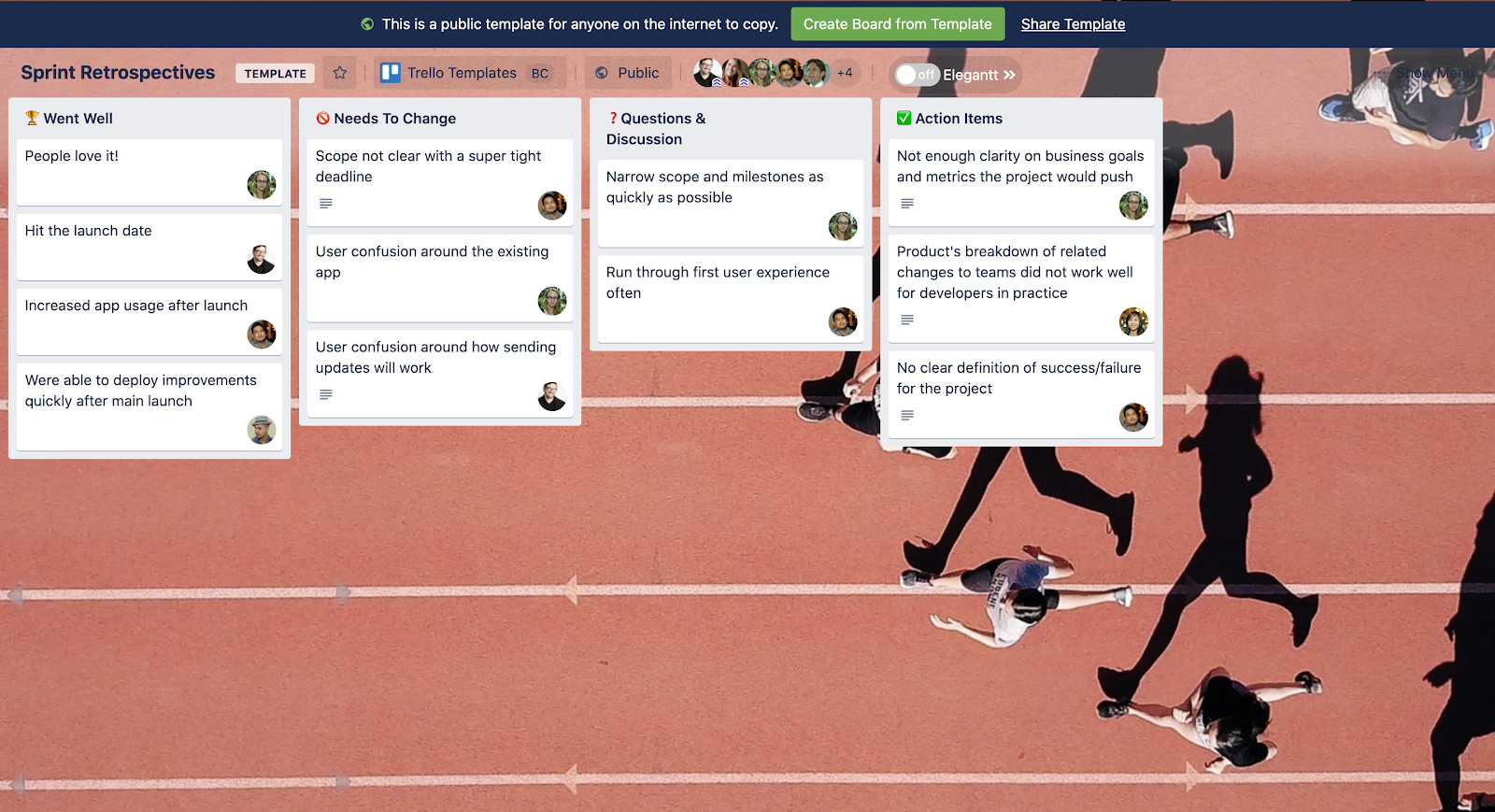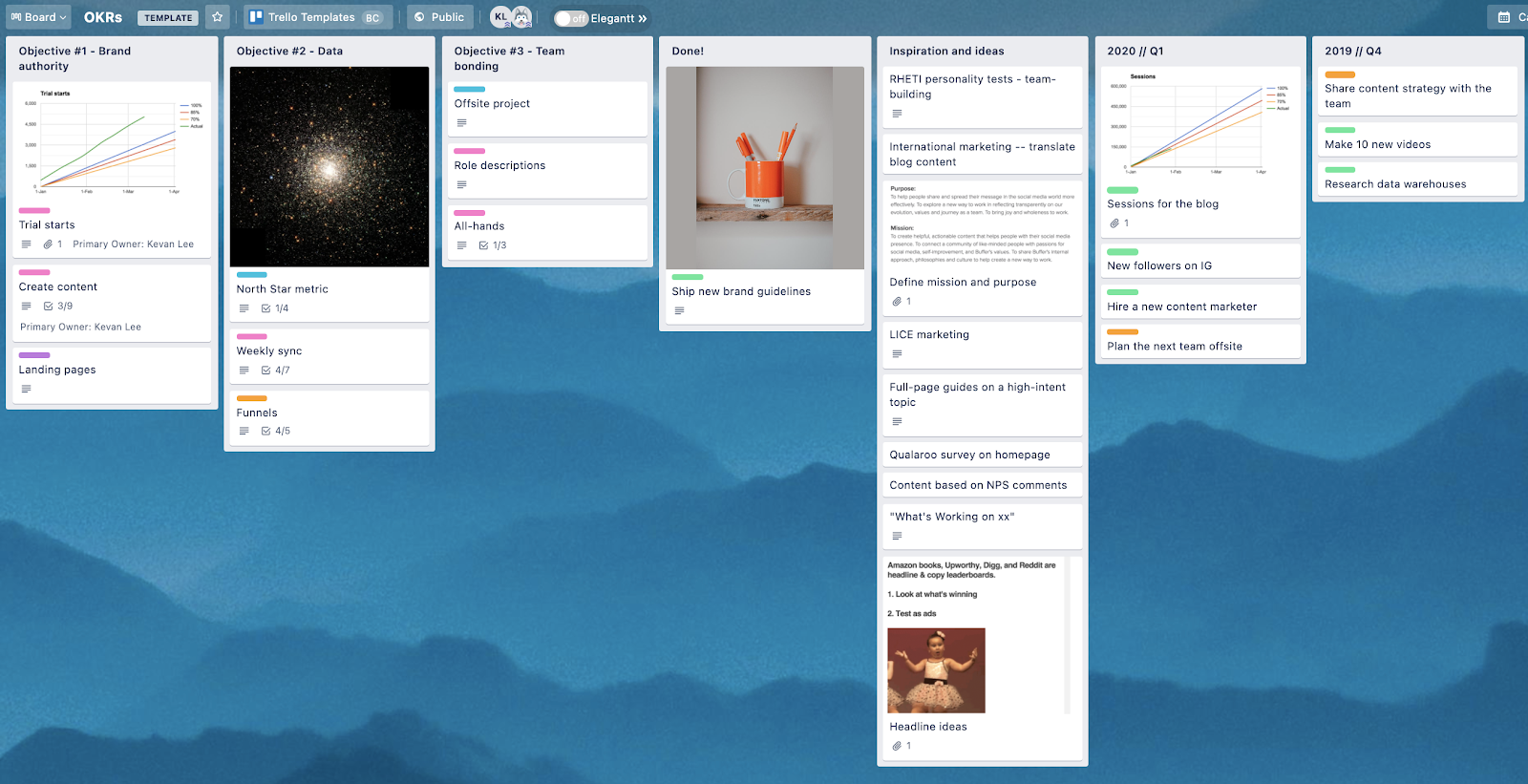Aristotle wisely said, “For the things we have to learn before we can do them, we learn by doing them.” But if you never learn from what you have done, how are you moving forward? In order to prevent team efforts from ending up on a never-ending hamster wheel, teams must reflect on the past in order to propel forward more efficiently.
The relationship between team reflection and planning is connected by knowledge. Teams must learn from their past, reflect on it, and decide what to bring (and to discard) as they move forward with care.
How do teams learn? By involving each team member in the collective decision to grow. Benjamin Franklin once said, “Tell me and I forget, teach me and I may remember, involve me and I learn.”
Teams of all types can take a page out of agile tech teams’ books—who successfully run project sprints (short-term, fast-moving initiatives) and then come together afterwards to reflect, plan, and improve. The goal is to move faster and become better with every sprint. This success relies on a clear understanding of the collective failures, hurdles, and successes of the past. Teams must learn to work around their mistakes and blockers—and look to their successes for guidance forward.
Read on to uncover the importance of a team reflection and how it influences a team’s ability to plan for a brighter future, as well as how to host successful team reflection and planning sessions.
The Benefits Of A Team Retrospective And Reflection
A team retrospective is a group reflection that aims to reveal which processes worked, which didn’t, and how to improve for the future. It is a structured meeting that involves reflection as one stage of it—and action as another.
Conducting a team retrospective following a sprint has many benefits. Not only do they help team members identify blockers and discuss potential solutions, but they allow teams to use their discoveries to work more efficiently and strategically for future endeavors.
In fact, Enterprise Knowledge found that sprint projects were completed in an average of 30% less time. This means that teams are not only talking about what’s working and what’s not, but also applying their learnings. In businesses where time means money, working faster and more efficiently can mean big savings. “Agile retrospective sessions actually save time,” explained Software Dev Tools. “The team works better together and brings up topics that wouldn’t organically come up, and it significantly increases our communication and credibility as a team.”
Retrospectives can even flag problems before they occur. Attendees openly share their ideas on what worked and what didn’t—and provide input on what to start, stop, and continue doing.
A team reflection, on the other hand, can take many forms and may be less formal. Although it doesn’t necessarily involve the planning and strategizing stages that a retrospective has, we will show you how to combine the two.
Tips For Hosting A Successful Team Reflection
Retrospectives are a good idea for all types of teams. By working together to reflect on and discover what worked, what didn’t, and what can be improved on from the past, the future is brighter for everyone.
But, where to start? There are so many different strategies for hosting team retrospectives that it may seem overwhelming. Instead of panicking or going forward without a true plan, use these tips to conduct an effective retrospective with your team.
Use A Pre-Built Retrospective Template Within Trello
Sprint retrospectives are a good option for those teams that need to move forward quickly, but still must learn from the past to avoid hitting the same blockers or relying on the same solutions. Agile companies hold sprint retrospectives more frequently, such as every week or few weeks. They discuss what to start, stop, and continue doing—and check-in throughout initiatives.
Use this Sprint Retrospective template as a basic structure for your team retrospective—useful for teams of all types!

Use each list to organize what went well, what didn’t go so well, questions and discussion points, and finally—action items for next time. Team members can add their thoughts to each list as a card, and if they wish, add themselves as a member of the card so others can see who added which piece of feedback. During the meeting, go through each card and discuss it as a team. From doing this, you should be able to come up with some valuable discoveries.
Team Reflection On The Past Year Or Quarter
For longer-term strategic planning, such as annual planning, departmental goal-setting or large-scale campaign ideation, it’s a good idea to host a well-planned team reflection on the past year or quarter.
To prepare for this team reflection, gather a list or a visual representation of all of the major launches, initiatives, and projects that took place throughout the last year. This will help remind the team of all that you’ve accomplished together.
During the team reflection, have team members record down their answers to questions such as:
- What three words would you use to describe this past year?
- What are you most (and least) proud of accomplishing this year and why?
- What initiatives were the most (and least) successful for you and the team—and why?
- What should we start, stop, and continue doing?
- What conclusions can be made from this past year?
Whether your team is a small-but-mighty force or a larger group, you’ll be sure to leave with some insightful and valuable information to use going into your next chapter together.
Celebrate Team Achievements And Acknowledge Failures
Every team retrospective should celebrate the wins and acknowledge failures.
“Without retrospectives and deliberate celebrations, it can feel like constant joyless motion,” Andrea Fryrear, agile expert and author explains. Celebration keeps morale high, but also provides opportunities for finding unexpected wins.
Although spreading kudos and pats-on-the-back feel good and are necessary, it’s the negative feedback that leads to the improvement teams are really looking for. “Nothing is ever 100% perfect, and pretending like it hides opportunities for optimization,” Fryrear explains.
Set Goals For The Year As A Team
Now that you’ve spent some time in the past, it’s time to look forward.
The special space in the universe where your team reflections and future plans intersect is where magical things start to happen. It’s the moment where ideas come together, where your team’s efforts for improving the future really take off, and where real progress is made.
But how do you get there? Consider this an invaluable learning opportunity.
In order to look ahead, you must take a look at your year in review—but don’t get stuck there! As a team, make an agreement of what to let go of from past experiences, projects, and initiatives. This could be anything from meeting effectiveness or processes that never reached their fullest potential, team communication hurdles, or other areas that no longer serve your team.
Now do the opposite. What should your team carry forward or continue to do in the future? A few examples could be particular initiatives that performed well, the frequency of team meetings, or tools that help your team stay connected and engaged.
Determine Your Purpose And Timeline For Plans
Purpose. Although it’s a deep and loaded word that’s often the center of philosopher’s theses, it’s also an important determinant of everything you and your team does. Intimidated? Don’t fret, simply consider the purpose that your team is planning for.
What are your company’s goals? Do your team goals align with them? Are all teams and areas of the company in alignment? Schedule a planning session with your team and other teams within the company to make sure everyone stays on the same page, aligns with the same goals, and understands their role within those goals.
Planning sessions among a company’s leadership team for the year will differ from individual team plans on a quarterly or initiative-level, but they should all fit together like a puzzle.
Next up: Setting clear timelines. This is an essential practice for two reasons: to establish expectations for the planning session and to plan and forecast in an organized fashion.
Leading up to the planning session, it’s helpful to have a timeline documented (or at least in mind!). Having a clear schedule and list of objectives prepared for your planning session helps to establish expectation—and may improve engagement.
A timeline for the year or quarter ahead that you’re planning for should include any events or initiatives that are already on the calendar. Consider what is missing from your calendar as well, and how much time is needed for each project.
Insert Team Needs And Wants Into Your Future
What did your team uncover as your “non-negotiables”, wants, and needs? How do they tie back to your purpose and timeline?
Let’s say that during your reflection meeting, your team decided that an extra monthly team meeting is necessary for success in the future. Bring this team exercise full-circle by scheduling the extra team meeting into your timeline and reminding members of its higher purpose.
Putting your decisions into action could inspire even more positive change!
Define Your Teams Objectives During The Planning Session
Goal setting is important for both your planning session and beyond. ‘Beyond’ as in, next year when your higher-ups ask “what were the goals, and did you achieve them?”
During your planning sessions, set clear objectives for each initiative and ensure that attendees have all of the information necessary for success.
One helpful goal-setting method is to follow SMART goals, which refer to goals that are Specific, Measurable, Achievable, Relevant and Timely. Ensure that they support your needs and wants as a team, as well as larger company goals. Don’t forget about your team reflections and what you agreed to stop, continue, and start doing.
Now that you’ve set your team goals, it’s time to put great minds together and figure out some ways to actually accomplish them!
Meet Next Year’s Goals With A Team Brainstorm
Team brainstorms are great for many reasons—a big one being their ability to help teams reach their goals.
When it comes to ideas, the more the better. Because there is no right or wrong in brainstorm sessions, team members tend to be less inhibited. This can boost more creative thinking and diverse ideas and perspectives from all attendees, including those who tend to shy away from group engagement.
After all, great ideas have the power to inspire and lead to even more great ideas.
Like team reflections, brainstorms offer an opportunity to bring team members together, gauge morale, and increase and diversify social interactions in an open environment. Follow these tips for ultimate brain-power-victory.
Create A Safe Environment And Equal Playing Field
Team brainstorms and reflections have similar rules. Rule number one is to create a safe, supportive space (whether in-person or virtually) where everyone feels confident to engage. If some people tend to dominate the conversation, get creative with different brainstorming techniques that involve everyone.
This could be as simple as having everyone share one possible idea and one impossible idea—and seeing what grows from there! This way, everyone contributes and no ideas are “wrong ideas.”
Techniques For Team Brainstorm Sessions
Start your team brainstorming session off by reminding participants of the objectives, purpose, and timeline you’ve established for the year or quarter ahead. Create a list of topics that require brainstorming.
Go over what you’ve already established in your team reflections: Do upcoming product launches require more attention to detail? Does the team as a whole need more support? Does the marketing team need a better tool for reporting? The next steps should be to capture ideas, talk about them and decide on the best ones to pursue. But how?
Try out the following strategies for capturing your team’s ideas. Remember: sometimes a new method can help spark better ideas.
Round-Robin Brainstorming: To host a successful round-robin brainstorm session, go continuously around the room (or virtual meeting) and have everyone share one idea on the topic of discussion. If an idea has already been said, come back to that person to give them time to come up with a new idea. This technique works best when team members have time to prepare a few ideas, so allow time beforehand by providing team members with an agenda of the topics.
Only once every team member has suggested an idea can the discussion continue around the room again. During the second and consecutive times around the room, team members can suggest new ideas or expand on and discuss other ideas. After several times around, some ideas will rise to the top and can be discussed and decided upon in a similar format.
Brain-writing: Get the ideas flowing with a team brain-writing session. Give each team member some time to write down three ideas that relate to each topic at hand. Once that is completed, have team members share their ideas with another individual who will expand on and add to the ideas. This can easily be done via Trello, simply create a list for each topic, a card for each idea, and have team members add their thoughts to each card. Continue to share and expand on ideas until everyone has added to every idea.
Depending on the group dynamic, discussing and voting on the ideas can go one of a few ways. Consider either voting on the ideas individually and then discussing them, or discussing and voting on them as a group. The initial strategy may help eliminate challenges of groupthink or unbalanced conversations—and let the best idea (rather than the most talked about) rise to the top.
Use the Voting Power-Up to do this within Trello! With this Power-Up, a simple appears on your card as the rest of the board members vote on each card.

Mind Mapping: Mind mapping is a visual brainstorming technique and one that can be done both as a team or individually and discussed together afterward. To experiment with this technique, have everyone start with a topic or idea and get them to write it down in the center of their paper and circle it.
From there, have them add related ideas. Draw lines to connect each related idea. Any unrelated ideas can start a new branch of the mind map. This strategy is useful for coming up with new and better ideas if the first is okay, but not quite right.
Storyboarding: Storyboarding can be a helpful visual technique for brainstorming, especially if there are multiple factors at play. In a Trello board, add the considerations as Lists, such as goals, problems and solutions, for example. Have team members add the potential problems and ideas for solutions within each goal as a card.
As a team, organize the ideas and decide on which ideas to keep. Sometimes, seeing ideas laid out and understanding how they’re connected triggers better solutions. If several ideas still need fleshing out, expand on the storyboarding process.
Record and Reflect On The Brainstorm Session Results: So, what do you do with all of this amazing information and data, and these brilliant ideas and plans? Record the top takeaways, action items, and timelines in a Trello board so the entire team (and company!) can access the information and refer back to it mid-project. Name it something like “2020 Reflections + 2021 Planning”.
When the time comes to do these practices again, your team will have a documented process of how to do so and what was agreed on.
Need a way to make recording this information easier? Use the OKRs (Objectives and Key Results) template for an out-of-the-box solution.

Put Team Plans And Goals Into Action
Congratulations! You’ve done the hard work of organizing and facilitating your team reflection and planning sessions—now it’s time to put your learnings and ideas into action.
Remember, the relationship between team reflection and planning is the knowledge discovered along the way and what you do with it.
With a collective agreement and understanding of how you came to your conclusions and plans, your team will feel more unified and better prepared to tackle upcoming projects together.





 )
) 




































